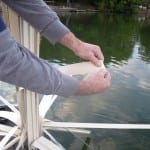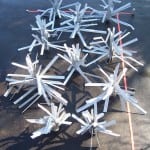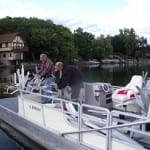“LAND CONSERVATION IS FISH CONSERVATION”
The Fisheries Habitat and Ecosystem Program (FHEP) is working to understand how habitat changes impact Maryland’s fisheries in the Chesapeake Bay. Our focus has been primarily on understanding how urbanization limits habitat for fish. See the dozens of unique artificial fish habitat models, fish attractors and fish cover used at fishiding.com, the leader in science based, proven, fish protection.
Maryland’s population and land use has increased significantly. The amount of land being developed outpaces population growth. Between 1973 and 2010, developed land increased by 154 percent while population grew by only 39 percent. By 2035, 1,000,000 new residents and 500,000 new homes will be added to Maryland according to the Department of Planning.
Studies by the Fisheries Habitat and Ecosystem Program have found strong links between increased development and declining fish habitat quality in tidal tributaries of Chesapeake Bay. These links have led to creation of thresholds and targets for development to consider when managing fisheries and planning for development. These thresholds and targets use impervious cover (hard surfaces such as pavement and rooftops that are impenetrable to runoff of rain and snow melt) as a measure of development. Impervious surface thresholds describe tipping points where habitat becomes poor for fish and shellfish. This is the upper limit of impervious surface. Development beyond this limit will severely limit habitat for fish and shellfish. Impervious surface targets describe a development level that can be considered safe for fish and shellfish habitat. These targets and thresholds are being communicated to planners and the public through a simple message, “land conservation is fish conservation!” as a reminder that forests, wetlands, other natural areas, and working farms are keys to productive Chesapeake Bay fisheries.
 It is clear that development is a major threat to Maryland’s natural resources and the critical ecosystem functions provided by watersheds. The impact of development on aquatic habitats is quite well documented in the scientific literature. Impervious surface increases flow extremes (lower lows and more flooding), erosion, and sediment. As trees are lost, runoff temperature of water increases. Nutrients from developed lands can be as plentiful as nutrient inputs from agriculture and cause algae blooms that deplete oxygen. In winter, more roads require more salt that pollutes streams and kills freshwater organisms, including fish. Other pollutants such as toxic metals (lead for example) and organic pollutants (oil, grease, and pesticides) enter waterways in urban runoff and wastewater. Some compounds that enter wastewater treatment facilities may not be removed. These compounds may reduce success of fish spawning and make fish less safe to eat. Fish become less abundant and less diverse in polluted waters that result from high development and impervious surface.
It is clear that development is a major threat to Maryland’s natural resources and the critical ecosystem functions provided by watersheds. The impact of development on aquatic habitats is quite well documented in the scientific literature. Impervious surface increases flow extremes (lower lows and more flooding), erosion, and sediment. As trees are lost, runoff temperature of water increases. Nutrients from developed lands can be as plentiful as nutrient inputs from agriculture and cause algae blooms that deplete oxygen. In winter, more roads require more salt that pollutes streams and kills freshwater organisms, including fish. Other pollutants such as toxic metals (lead for example) and organic pollutants (oil, grease, and pesticides) enter waterways in urban runoff and wastewater. Some compounds that enter wastewater treatment facilities may not be removed. These compounds may reduce success of fish spawning and make fish less safe to eat. Fish become less abundant and less diverse in polluted waters that result from high development and impervious surface.
“Every Maryland citizen lives within at least 15 minutes of a stream or river” – Maryland StreamHealth
FHEP Goals and Objectives
Our goal is to develop ecosystem-based fishery management strategies that will sustain fish communities in the future. In order to do this, we are working to identify fishery and ecosystem interactions with land use and water quality stressors. We work with the public and other local, state, and federal government agencies to enable Maryland’s Fisheries Service to develop ecosystem-based fishery management strategies that sustain services by fish (including shellfish) communities into the future. The role of others in ecosystem-based management is important since Fisheries Service (and even DNR) does not have authority to manage whole watersheds.


- 5% or less Impervious
Watersheds with 5% or less impervious surface represent target conditions. They have healthy fisheries. Habitat within the watershed is productive. Active engagement by the public and planning officials should be taken at this stage to protect, conserve, and sustain healthy fish habitat.
- 5% – 10% Impervious
Fish habitat in watersheds between 5% – 10% impervious surface may begin to decline. Fish reproduction may become less successful as spawning habitat becomes increasingly impaired. Habitat for juvenile and adult fish becomes increasingly compromised. The public and planning officials need to conserve remaining habitat, minimize additional impacts, and revitalize damaged areas.
- 10% or Greater Impervious
Watersheds with 10% or greater impervious surface are facing the “point of no return” of a tidal tributary to a very different and less productive status than when the watershed was less developed. Fish habitat is impaired from a variety of stressors at this stage and could be beyond the point of no recovery as development continues. Restoring a watershed to its target condition is very unlikely, but some functions might be reconstructed with limited positive success. Ecological reconstruction projects such as stormwater retrofit, impervious surface removal, or tree planting/revegetation can help mitigate impacts by reducing sedimentation and infiltrating groundwater. However, watersheds with greater than 25% impervious surface are highly altered systems, with little chance of restoring ecological integrity. Studies of restored streams do not show successful biological restoration in highly urbanized areas. In these cases, the public and planning officials should first restructure and redevelop areas of impervious surface in a watershed before attempting restoration projects.
Understand and learn what is happening in your backyard…
 As fishermen, who use and enjoy Maryland’s natural resources, it is important for you to understand and learn what development and environmental impacts are occurring “in your own backyard.” The following links provide information and facts about the areas in which you may fish and-or live.
As fishermen, who use and enjoy Maryland’s natural resources, it is important for you to understand and learn what development and environmental impacts are occurring “in your own backyard.” The following links provide information and facts about the areas in which you may fish and-or live.
Fishermen and the public can get engaged in the planning process…
Fishermen are familiar with Maryland’s natural resources; however, there may be times in which you, as a fisherman, feel that you have no control in what is occurring around you and to your natural resources. If you are concerned you can engage in your county and watershed planning processes. The following links provide information and contacts that can help you take part in the development and land use decisions taking place in your watershed and community.

















